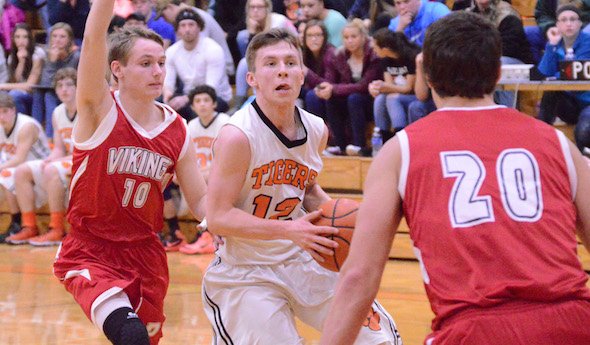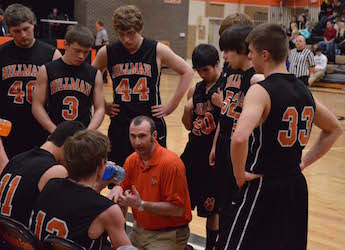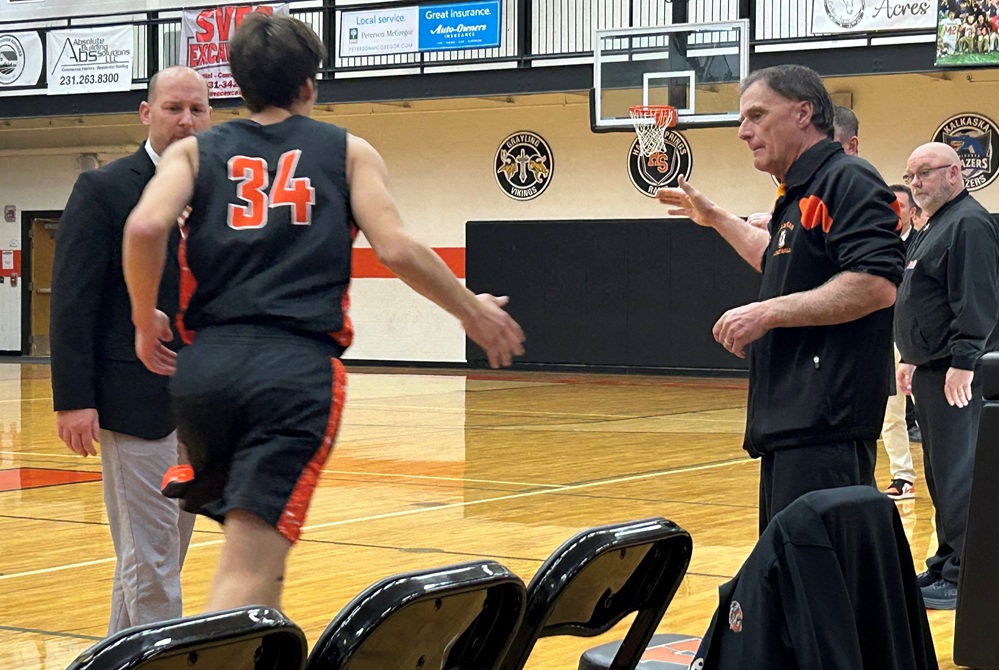
Hillman Becomes Basketball Town, Too
January 6, 2017
By Dennis Chase
Special for Second Half
HILLMAN – Eric Muszynski still remembers that day in 2005 when, as the newly appointed boys basketball coach at Hillman, he made a promise to the man who hired him, administrator Jack Richards.
 As they gazed at the banners in the school gymnasium – highlighted by the school’s three MHSAA Class D championships in baseball – Muszynski vowed to add some basketball banners to the collection.
As they gazed at the banners in the school gymnasium – highlighted by the school’s three MHSAA Class D championships in baseball – Muszynski vowed to add some basketball banners to the collection.
“He (Richards) chuckled,” Muszynski recalled. “He said, ‘Try to get to .500 first.’”
Historically, Hillman’s been a baseball town. The Tigers played for MHSAA championships four times in six years during the 1990s.
“Basketball was something you did to stay in shape for baseball,” said Richards, who went on to serve as superintendent for five years. “Eric’s turned that around.”
Since 2009, Hillman has won four North Star Conference basketball championships, five Districts and one Regional. The Tigers stretched their regular-season win streak to 44 after Thursday night’s 68-38 victory over Mio. Their last regular-season loss was to Cedarville in the 2014-15 opener.
Quite a turnaround for a program that had won only one league title prior to Muszynski’s arrival.
“And that wasn’t an outright title,” senior guard Gunnar Libby said.
Libby, a first-team Associated Press all-state pick last season, is the catalyst for this 5-0 Tigers team. A four-year varsity veteran, Libby has played a vital role in the program’s growth. Hillman won its first outright league title when he was a freshman, captured its first Regional crown when he was a sophomore, and posted its first unbeaten regular season when he was a junior.
“I’ve been really lucky to play on some good teams,” he said.
The turnaround did not happen overnight. The Tigers were 10-32 in Muszynski’s first two years.
“I remember thinking to myself, ‘Will we ever get over that hump?’” Muszynski wondered.
His boss stood by him.
“I had some people come to my office, saying he wasn’t the guy for the job,” Richards said. “I told them, ‘Settle down. This guy will bring us championships.’ Eric heard me, and he took it to heart. He worked hard to prove me right.”
In his third season, Muszynski led Hillman to an 11-10 mark. From there, the program took off.
“It’s been truly amazing,” the former Alpena High School standout said. “As a coach, you envision and hope that your program can do big things. We’ve been in that conversation – of trying to get down to East Lansing (for the Final Four) – since 2013 when we almost upset Cedarville (a double overtime loss) in the Regional Final.”
Hillman, sparked by Mason VanPamel and Ty Jones, reached the Quarterfinals in 2015 before losing to eventual champion Powers North Central.
It looked like the Tigers might be in for a rebuild last season, losing eight seniors and four starters to graduation. Instead, Hillman won its first 22 games before losing to Onaway 58-57 in the District Final.
“We were counted out from the very beginning,” Libby said. “We proved everybody wrong.”
Still, the setback to Onaway – a team Hillman had knocked out of the Districts the previous three years – left a bitter taste. Onaway reached the Quarterfinals, but that loss motivates the Tigers.
When his team first gathered for practice this season, Muszynski stressed the importance of “protecting” its league title as well as recapturing the District championship. Hillman had won three Districts in a row before its sudden exit last March.
“That District (trophy) should be in Hillman,” Libby said.
That statement reflects how far this program has evolved. It’s a program that’s now won 46 consecutive league games and 36 consecutive home games.
Those streaks continue to grow, although Libby admitted he’s lost count.
“You just go out there and do what you’ve got to do,” he said.
The 5-foot-9 Libby is the floor general and lone senior in the starting lineup. He averages 25 points and six assists per game. He surpassed 1,000 career points in the season opener when he dropped 30 on Cedarville.
“He’s lightning quick,” Muszynski said. “He’s a tough kid; a hard-nosed, old school style point guard.”
Libby’s backcourt mate, 5-10 junior Brandon Banks, averages nearly 15 a game.
“That’s been our recipe for success since 2009,” Muszynski said. “We usually feature two dynamic scorers.”
Andrew Funk, a 6-foot junior, is also averaging in double figures. He scored 19 in Tuesday’s win, hitting five of Hillman’s 13 3-pointers.
The Tigers compensate for lack of size with speed, a trapping defense and a dangerous perimeter game. Kory Henigan, a 6-4 sophomore, and Billy Kolcan, a 6-1 junior, are the tallest starters. Henigan averages eight points and seven rebounds while the athletic Kolcan, an MHSAA Finals qualifier in track and an honorable mention all-state player in football, spearheads the press.
 “He (Kolcan) plays up front on our press,” Muszynski said. “He makes us go. He’s one of the best athletes to come through our school in a long time.”
“He (Kolcan) plays up front on our press,” Muszynski said. “He makes us go. He’s one of the best athletes to come through our school in a long time.”
Kolcan, Banks and Funk were on varsity as sophomores last season.
“On paper, it appears we’re young,” Muszynski said. “But we’re battle-tested.”
And, according to Libby, cohesive, too.
“We work well together,” Libby said. “We’re unselfish – and we scrap.”
Now, the Tigers would like to start playing more basketball. Hillman played just three games in December after two contests were postponed due to weather.
“It’s hard to get any kind of rhythm and consistency when you play two games, then you’re off two weeks, you play one game, then you’re off another two weeks,” Libby said.
As for Muszynski, this is his 12th season at Hillman. He was hired as a physical education/health/social studies teacher and girls basketball coach. When the boys job opened soon afterward, he added that to his responsibilities. He coached both teams for two years before the MHSAA switched girls basketball season to the winter. Even though the girls were 30-12 in those two seasons under his leadership, he felt coaching boys basketball was his calling.
“I liked the challenge,” he said. “With the girls, I walked into a good program. With the boys, I wanted to see if I could build a program.”
With a win over Rudyard just before the holiday break, the 37-year-old Muszynski notched his 200th career win at Hillman (30 with the girls, 170 with the boys).
“He’s been a real blessing for us,” Libby said. “He’s a great coach. He holds us all accountable. He’s thorough, and he can motivate. He knows his stuff.”
“I’m truly blessed,” Muszynski added. “That’s (200 wins) a credit to my players, past and present.”
Muszynski echoed those same sentiments after he won the Associated Press Class D Coach of the Year honor last season.
“One of the proudest moments in my coaching career,” he admitted. “Not only was it a great reward, but it was a reflection of our basketball program here.”
Richards, meanwhile, takes satisfaction in the basketball program’s accomplishments. Now retired, he still follows the Tigers – and Muszynski.
What did he see in Muszynski when he hired him in 2005?
“He has a drive,” Richards said. “He knows what it takes and the work that’s involved. A lot of people just want to work during the season, and when it’s over they’re done. That’s not Eric. He’s a worker, a planner. You could see his desire.”
Richards also feared, once the boys started winning, that Muszynski might leave for a bigger school. He even mentioned that to Muszynski.
“Eric said, ‘You gave me the opportunity to be a head coach and I want to do right by you,’” Richards recalled. “I said, ‘I understand that. But let me give you a piece of advice: it’s easier to build a dynasty in a small town than in a large town.’ I think he’s done a pretty good job with that.”
Muszynski looked north to Cedarville for inspiration. Coach Dave Duncan developed that program into a state contender. The Trojans won an MHSAA title in 2007 and nearly another two years later.
“I thought if a small Class D school in the Upper Peninsula can do that, why can’t we?” Muszynski reasoned.
One of Muszynski’s first priorities was to start applying his philosophies in the youth program so by the time those players reached the varsity they would know the defensive schemes and offensive sets.
“They’ve seen success so they know the formula works,” Muszynski said. “If you have some success, and start to win championships, everyone starts to buy in.”
As for baseball? Practice is still several weeks away.
“When I first got there,” Richards recalled, “the kids, after basketball practice, would put their gloves on and throw the baseball around. They even had a batting cage in the old gym. Now, you don’t see a baseball glove in the gym during the winter.”
Now you see basketball banners.
 Dennis Chase worked 32 years as a sportswriter at the Traverse City Record-Eagle, including as sports editor from 2000-14. He can be reached at [email protected] with story ideas for Manistee, Wexford, Missaukee, Roscommon, Ogemaw, Iosco, Alcona, Oscoda, Crawford, Kalkaska, Grand Traverse, Benzie, Leelanau, Antrim, Otsego, Montmorency, Alpena, Presque Isle, Cheboygan, Charlevoix and Emmet counties.
Dennis Chase worked 32 years as a sportswriter at the Traverse City Record-Eagle, including as sports editor from 2000-14. He can be reached at [email protected] with story ideas for Manistee, Wexford, Missaukee, Roscommon, Ogemaw, Iosco, Alcona, Oscoda, Crawford, Kalkaska, Grand Traverse, Benzie, Leelanau, Antrim, Otsego, Montmorency, Alpena, Presque Isle, Cheboygan, Charlevoix and Emmet counties.
PHOTOS: (Top) Gunnar Libby, who has scored more than 1,000 points during his Hillman career, cuts through a group of defenders. (Middle) Hillman coach Eric Muszynski addresses his team. (Photos courtesy of The Alpena News.)

'Scott Hancock Court' Celebrates JV Coach's 50 Years Building Up Cheboygan Hoops
By
Tom Spencer
Special for MHSAA.com
December 19, 2025
It’s been a remarkable season so far for the Cheboygan boys basketball players and coaches.
 The undefeated varsity Chiefs are looking ahead to the new calendar year and their next opponent, Northern Shores Conference rival Elk Rapids. They also have the District tournament they’ll be hosting in February in their sights.
The undefeated varsity Chiefs are looking ahead to the new calendar year and their next opponent, Northern Shores Conference rival Elk Rapids. They also have the District tournament they’ll be hosting in February in their sights.
But Scott Hancock is already looking ahead to the classes of 2035, 2036, 2037 and 2038. And nobody can blame him.
Hancock, a 1976 graduate of Cheboygan, has no intentions of ending his coaching career soon. He’d like to make it long enough to coach his youngest grandson Lincoln Hancock, who is already playing youth basketball in Cheboygan.
And while the Chiefs are finding success this year with the foundation Hancock helped build, the veteran coach can’t help but dream about his youngest grandson playing at Cheboygan High School.
“As a kindergartner he’s in Saturday basketball, and he loves the game,” Hancock said. “God willing, I plan to be there for him.”
Hancock is his 50th season in Cheboygan program. He enjoyed the opportunity to coach his two sons Nick and Brian, both school record holders. He’s also enjoyed coaching his grandson, Landon Gahn, the Chiefs’ junior point guard. Gahn played junior varsity for Hancock his freshman year and moved up to the varsity his sophomore season.
All but two of Hancock’s season were spent as the JV coach. He took the varsity job on an interim basis when current Cheboygan varsity coach, Jason Friday, was playing for the Chiefs in the late 1990s.
On Dec. 9, the Chiefs officially named their home court the Scott Hancock Court. His family was on hand as well as current and former Northern Michigan coaches.
Hancock’s JV team lost that night to Alpena in overtime. The score was 50-50 when the fourth quarter buzzer sounded.
“Looking back, we should have just called the game at the end of regulation,” Hancock admitted. “I got a bunch of great kids this year. and it was a tough loss because it was an overtime loss.”
 It was the only loss the Chiefs’ JV team has encountered so far this year. But wins and losses are not the focus of Hancock’s level of the program.
It was the only loss the Chiefs’ JV team has encountered so far this year. But wins and losses are not the focus of Hancock’s level of the program.
“I don't get too carried away with the wins and losses — I know what I'm there for,” Hancock explained. “I'm there to teach the kids to get them ready for the varsity.”
Hancock is considered by many to be the best coach in Cheboygan history. No counter argument can be found among the current varsity players and their head coach.
“He's the best coach that I've ever had — no bias because he's my grandfather,” acknowledged Gahn, who was found cheering from the bench as the Chiefs secured the victory earlier this week at Kingsley. “He teaches everything about basketball, but he doesn't really preach as much as he demonstrates being a good person. Just looking at him and what he does every day, you can just tell he's the guy that's doing everything right, even though nobody's watching.”
Senior Carson Kiefer helped lead the way for Cheboygan's varsity at Kingsley. He scored 12 points, with two 3-pointers. Kiefer credits Hancock for helping him improve his confidence on the court.
“I think he cares more about the person individually outside of sports,” said Kiefer, who is averaging 16 points per game. “It's fitting that he's a JV basketball coach, helping build players’ skills and confidence.”
Kiefer’s twin brother, Andrew, singled out Hancock’s commitment to the school.
“He's not just a school figure,” said Andrew Kiefer, who is averaging just under 12 points per game. “He is not just the coach. He is a community guy all-around.”
The Chiefs varsity is getting strong contributions from their juniors this season. Nolan Schley is averaging 12 points per game, and he’s second on the team in rebounding. And Gavin Smith is leading the team in rebounds and assists, collecting almost 10 boards and four dishes per game.
The Kiefers, Smith and Schley are part of the reason Friday is not surprised by the 6-0 start and seeking a District title for the first time since 2015. The last time Cheboygan won a conference championship was 2020, playing in the Straits Area Conference during Friday’s first season as boys head coach after previously coaching the girls varsity.
 “We knew that our junior and senior classes had some talent in there,” Friday noted. “The boys really want to win a District championship, as well as a conference championship. The boys put a ton of time in the offseason to do everything they can to get over that hump and get both a conference and District championship.”
“We knew that our junior and senior classes had some talent in there,” Friday noted. “The boys really want to win a District championship, as well as a conference championship. The boys put a ton of time in the offseason to do everything they can to get over that hump and get both a conference and District championship.”
Cheboygan will host a Division 2 District tournament this season after falling 50-48 in last year’s Division 3 District Final – also at home. The Chiefs face a field including league foes Grayling, Kalkaska and Kingsley as well as Ogemaw Heights and Sault Ste. Marie. Cheboygan topped the Sault 67-43 earlier this year and will play a home-and-home series with Grayling in January.
For now, though, the Chiefs are thinking only about Elk Rapids. Cheboygan started 7-0 last year before falling to the Elks to start the new year.
“We're approaching 7-0 again, so having them coming up here on the schedule, we’re definitely going to be practicing a little harder and watching maybe a little more film and just preparing for the game more seriously,” Gahn said. “Coach Friday was saying last year that he can't remember the last time the team started off 8-0, and it was our eighth game that we lost to Elks. So we're hoping to beat them next time we play.”
The court naming did not come as a surprise to Hancock. He was informed in a meeting with Marty Mix, Cheboygan principal. He thought he had some papers to sign and was surprised his family was waiting in the office.
“He was completely shocked, and Coach Hancock doesn't like attention,” said Friday, who is also the school’s athletic director and was in the notification meeting. “Scott always likes to be in the background, and he handled it quite well.”
And while his signature was placed on the court opening day this year, he points out the Hancock legacy started way before him.
“I'm more proud of the Hancock name on there more than the Scott part of it,” said Hancock, who also serves as the city’s as the parks and recreation director. “Believe me, my dad was a Chief through and through. He passed in 2006. I know he was there in spirit with us looking down.”
 Tom Spencer is a longtime MHSAA-registered basketball and soccer official, and former softball and baseball official, and he also has coached in the northern Lower Peninsula area. He previously has written for the Saginaw News, Bay County Sports Page and Midland Daily News. He can be reached at [email protected] with story ideas for Manistee, Wexford, Missaukee, Roscommon, Ogemaw, Iosco, Alcona, Oscoda, Crawford, Kalkaska, Grand Traverse, Benzie, Leelanau, Antrim, Otsego, Montmorency, Alpena, Presque Isle, Cheboygan, Charlevoix and Emmet counties.
Tom Spencer is a longtime MHSAA-registered basketball and soccer official, and former softball and baseball official, and he also has coached in the northern Lower Peninsula area. He previously has written for the Saginaw News, Bay County Sports Page and Midland Daily News. He can be reached at [email protected] with story ideas for Manistee, Wexford, Missaukee, Roscommon, Ogemaw, Iosco, Alcona, Oscoda, Crawford, Kalkaska, Grand Traverse, Benzie, Leelanau, Antrim, Otsego, Montmorency, Alpena, Presque Isle, Cheboygan, Charlevoix and Emmet counties.
PHOTOS (Top) Longtime Cheboygan boys basketball JV coach Scott Hancock sends a starter onto the floor during introductions before a game against Kingsley. (Middle) The Hancock family takes a photo with Scott’s newly-added signature on the floor. From left: Landon Gahn, Brian Hancock, Olwyn Hancock, Scott Hancock, Marjean Hancock, Lincoln Hancock and Nick Hancock. (Below) Scott Hancock shakes hands with a Kingsley assistant coach. (Family photo courtesy of Chris Murdick. Other photos by Tom Spencer.)

